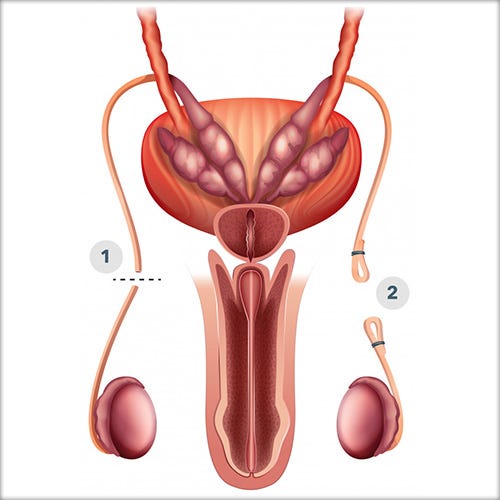A vasectomy is a common surgical procedure performed on males as a form of permanent contraception. It involves cutting or blocking the vas deferens, the tubes that carry sperm from the testicles to the urethra. By interrupting this pathway, sperm are unable to reach semen ejaculated from the penis, effectively preventing pregnancy during sexual intercourse.

Process of Vasectomy:
- Consultation and Preparation: Before the procedure, a consultation with a urologist or a healthcare provider is necessary. Medical history, risks, benefits, and alternatives are discussed. No-scalpel techniques are common, minimizing incisions and recovery time.
- Anesthesia: Local anesthesia is typically administered to numb the scrotum, ensuring minimal discomfort during the procedure. Sedation may be offered to alleviate anxiety.
- Accessing the Vas Deferens: Using a small puncture or incision, the urologist locates and accesses the vas deferens under the skin of the scrotum. The tubes are then isolated from the surrounding tissue.
- Interruption of Vas Deferens: The vas deferens is either cut, tied off, or sealed using heat (cauterization) or clips. This prevents sperm from mixing with semen during ejaculation.
- Closure and Recovery: The small puncture or incision is closed with dissolvable stitches or surgical glue. Recovery is generally quick, with minimal discomfort, though some swelling or bruising may occur.
Benefits of Vasectomy:
- Highly Effective: Vasectomy is over 99% effective in preventing pregnancy. Once sperm-free semen is confirmed through follow-up tests, it provides a reliable long-term contraception method.
- Permanent Contraception: Unlike temporary methods such as condoms or birth control pills, vasectomy is permanent. It eliminates the need for ongoing contraception management and is considered a one-time procedure.
- Low Risk and Complications: Complications are rare, with the most common being minor discomfort, swelling, or bruising post-surgery. Serious complications like infection or chronic pain are extremely uncommon.
- Cost-effective: Over time, vasectomy can be more cost-effective than other contraceptive methods that require ongoing purchases or prescriptions.
- Non-hormonal: Unlike some forms of birth control for women, vasectomy does not involve hormones, making it suitable for individuals with hormone sensitivities or concerns about hormone-based contraception.
- No Impact on Sexual Function: Vasectomy does not affect sexual desire, performance, or pleasure. It only prevents the release of sperm into semen during ejaculation.
- Reversibility: While vasectomy is considered permanent, it can sometimes be reversed through surgical procedures such as vasectomy reversal or sperm retrieval. However, success rates for reversal decrease with time and are not guaranteed.
In conclusion, a vasectomy is a safe, effective, and permanent form of contraception that provides numerous benefits for individuals and couples seeking reliable family planning. It allows for sexual spontaneity without the worry of unintended pregnancy and offers a straightforward outpatient procedure with minimal recovery time. Prior to undergoing a vasectomy, thorough discussion with a healthcare provider ensures understanding of the procedure, its implications, and consideration of alternative options if desired.
Comments
Post a Comment